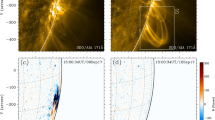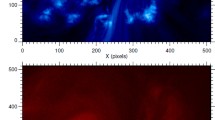Abstract
The white light coronagraph on Skylab observed many loop type coronal transients. These loops travel through the coronagraph's field of view (2–6R ⊙) over a period of a few hours, after which the legs of the loops usually remain visible for a few days. In this paper we investigate the temporal changes in density and mass per unit length measured along the legs of such loops during the several days after the initial eruption. Examination of 8 transients shows that the mass and density in the legs decrease during the few hours after the top of the loop has travelled beyond the coronagraph's field of view. The mass and density then increase slowly, during the next one half to one day, then decrease again over approximately the same period. These changes are generally shown to be too rapid to be explained by solar rotation, indicating that the transient legs have a lifetime of only a few days.
The results of a detailed study of the transient of 10 August 1973 are compared with the results from theoretical calculations. For the top of the loop a one-dimensional flow problem is solved, assuming a balance between gravity, inertia, and pressure gradients. The legs are modeled by a flow in a tube of constant cross section. Models for the flow in the legs were calculated under the assumption that the mass distribution is close to hydrostatic equilibrium. Using these models we can estimate that approximately 5 × 1014 g of material flow outward through the legs of this transient. We also find that the best fit to the observed average density gradient is obtained with a temperature of ∼1.7 × 106 K.
Similar content being viewed by others
References
Anzer, U.: 1978, Solar Phys. 57, 111.
Csoeke-Poeckh, A., MacQueen, R. M., and Poland, A. I.: 1977, Appl. Opt. 16, 931.
Gosling, J. T., Hildner, E., MacQueen, R. M., Munro, R. H., Poland, A. I., and Ross, C. L.: 1974, J. Geophys. Res. 79, 4581.
Gosling, J. T., Hildner, E., MacQueen, R. M., Munro, R. H., Poland, A. I., and Ross, C. L.: 1976, Solar Phys. 48, 389.
Hildner, E., Gosling, J. T., MacQueen, R. M., Munro, R. H., Poland, A. I., and Ross, C. L.: 1975a, Solar Phys. 42, 163.
Hildner, E., Gosling, J. T., Hansen, R. T., and Bohlin, J. D.: 1975b, Solar Phys. 45, 363.
Jackson, B. V. and Hildner, E.: 1978, Solar Phys. 60, 155.
MacQueen, R. M., Eddy, J. A., Gosling, J. T., Hildner, E., Munro, R. H., Newkirk, G. A. Poland, A. I., and Ross, C. L.: 1974a, Astrophys. J. 187, L85.
MacQueen, R. M., Gosling, J. T., Hildner, E., Munro, R. H., Poland, A. I., and Ross, C. L.: 1974b, Proc. Soc. Photo-Optical Eng. 44, 207.
Mouschovias, T. Ch. and Poland, A. I.: 1978, Astrophys. J. 220, 675.
Munro, R. H., Gosling, J. T., Hildner, E., MacQueen, R. M., Poland, A. I., and Ross, C. L.: 1979, this issue, p. 201.
Poland, A. I. and Munro, R. H.: 1976, Astrophys. J. 209, 927.
Saito, K., Poland, A. I., and Munro, R. H.: 1977, Solar Phys. 55, 121.
Author information
Authors and Affiliations
Additional information
On leave from Max-Planck Institut für Physik und Astrophysik, Munich, Germany.
The National Center for Atmospheric Research is sponsored by the National Science Foundation.
Rights and permissions
About this article
Cite this article
Anzer, U., Poland, A.I. Mass flow in loop type coronal transients. Sol Phys 61, 95–113 (1979). https://doi.org/10.1007/BF00155449
Received:
Issue Date:
DOI: https://doi.org/10.1007/BF00155449




